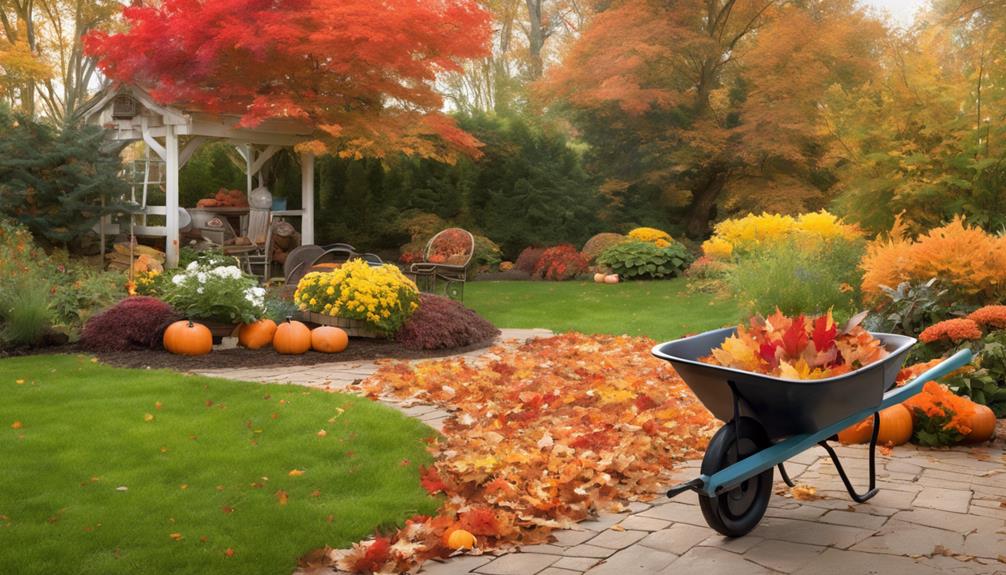Effortless Pressure Washing for Garden Access
7 March 2025
Patio and Deck Cleaning Halesowen
8 March 2025To achieve effective seasonal pest control, begin by identifying common pests and understanding their life cycles.
Conduct regular inspections to identify potential entry points and nesting areas. Implement preventive measures, such as sealing cracks and maintaining cleanliness to deter pests.
Early application of targeted treatments is essential when pest activity is detected. Consider using pest-resistant plants in your landscape to naturally deter unwanted species.
Furthermore, develop an integrated pest management strategy that rotates pest control methods to avoid the buildup of resistance.
These steps provide a solid foundation, and further insights can help refine your pest control approach.
Seasonal Pest Control Essentials
Understanding the common pests that emerge with each season is vital for effective pest control.
Implementing preventive measures and practices can significantly reduce the likelihood of infestations.
This section will examine how to identify these pests and the best strategies for maintaining a pest-free environment throughout the year.
Identify Common Pests
Identifying common pests is vital for effective seasonal pest control, as a proactive approach can greatly mitigate infestations. Familiarity with prevalent pests allows homeowners and pest management professionals to tailor their strategies effectively.
Common pests vary with the seasons; for instance, ants and termites are often more active in warmer months, while rodents may seek shelter during colder periods. Furthermore, bedbugs and cockroaches can persist year-round, necessitating vigilant monitoring.
Recognising the characteristics, behaviours, and habitats of these pests is fundamental for accurate identification. This knowledge empowers individuals to implement targeted interventions, ensuring that control measures are both efficient and effective.
Ultimately, mastering pest identification lays the groundwork for successful seasonal pest management and long-term prevention strategies.
Preventive Measures and Practices
Effective pest control begins with the implementation of preventive measures and practices that address specific seasonal challenges.
To start, conduct regular inspections of your property to identify potential entry points and nesting sites. Seal cracks and gaps around windows, doors, and foundations to deter pests from infiltrating your space.
Maintaining a clean environment is vital; promptly remove food debris and manage waste effectively. Additionally, consider landscaping practices such as proper drainage and keeping vegetation trimmed to minimise pest harborage.
Utilising natural repellents, such as essential oils or diatomaceous earth, can further enhance protection.
Lastly, establish a routine monitoring schedule to assess the effectiveness of your strategies, allowing for timely adjustments to your pest management approach.
Pest Life Cycle Awareness
Understanding the pest life cycle is essential for effective pest control. Temperature fluctuations and moisture levels greatly influence pest growth and reproductive rates, potentially leading to increased infestations.
Furthermore, awareness of how pests develop resistance to treatments can inform more strategic approaches to managing their populations.
Temperature Fluctuations Impact Pests
As temperature fluctuations occur throughout the seasons, they play an integral role in determining the life cycles of diverse pests.
These changes in temperature can accelerate or delay development, leading to significant impacts on pest populations. Understanding these dynamics is vital for effective pest management.
- Increased Reproduction Rates: Warmer temperatures can lead to more rapid breeding cycles.
- Extended Activity Periods: Pests may remain active for longer during warmer months.
- Survival of Overwintering Species: Milder winters can improve survival rates of pests.
- Altered Feeding Habits: Temperature variations can affect the feeding patterns of certain pests.
- Shifts in Geographic Distribution: Some pests may expand their range due to changing climatic conditions.
Moisture Levels and Pest Growth
Moisture levels play a significant role in the growth and proliferation of various pests, influencing their life cycles and population dynamics. High humidity creates an ideal environment for pests, fostering reproduction and survival. Understanding this relationship is vital for effective pest management strategies.
Key considerations include:
- Breeding Grounds: Stagnant water sources provide breeding sites for mosquitoes and other pests.
- Structural Damage: Excess moisture can weaken building materials, attracting termites and carpenter ants.
- Food Sources: Mould and dampness attract pests such as cockroaches and rodents seeking sustenance.
- Habitat Suitability: High moisture levels increase the likelihood of infestations in indoor environments.
- Life Cycle Acceleration: Elevated humidity can shorten the developmental stages of various pests, leading to quicker population surges.
Maintaining ideal moisture levels is fundamental for pest control.
Pest Resistance to Treatments
Pest resistance to treatments is an increasing concern in pest management, particularly as diverse species evolve in response to chemical and biological controls.
Understanding the life cycles of pests is essential for implementing effective management strategies. Awareness of these cycles aids in timing interventions to improve efficacy and mitigate resistance development.
Key strategies to combat pest resistance include:
- Rotation of treatment methods: Utilise different classes of pesticides to prevent adaptation.
- Integrated Pest Management (IPM): Combine biological, cultural, and mechanical controls with chemical methods.
- Monitoring pest populations: Regularly assess pest levels to inform timely interventions.
- Educating stakeholders: Provide training on pest life cycles and resistance issues.
- Adopting preventive measures: Implement sanitation and exclusion techniques to reduce pest pressures.
Apply Targeted Treatments Early
Applying targeted treatments early is crucial for effective pest control, as it allows for the identification of pest hotspots before infestations escalate.
Regular inspection and monitoring play a vital role in recognising early signs of pest activity, enabling timely interventions.
Implementing integrated pest management strategies further enhances the effectiveness of these treatments, ensuring a comprehensive approach to pest control.
Identify Pest Hotspots Early
Identifying pest hotspots early can significantly enhance the effectiveness of your pest control strategy. By pinpointing areas of high pest activity, you can implement targeted treatments that mitigate infestations before they escalate.
Here are key considerations for identifying these hotspots:
- Observe Environmental Conditions: Monitor temperature, humidity, and moisture levels.
- Inspect Common Entry Points: Check doors, windows, and vents for potential access.
- Survey Landscapes: Assess gardens, trees, and shrubs that may harbour pests.
- Utilise Traps and Baits: Employ monitoring tools to detect pest presence and activity.
- Engage Professional Services: Consult pest control experts for thorough inspections and assessments.
Regular Inspection and Monitoring
Regular inspections and monitoring are essential components of an effective pest control strategy, ensuring that any signs of infestation are promptly addressed.
By implementing a systematic approach, property owners can detect potential issues before they escalate, enabling targeted treatments early in the infestation cycle.
To enhance your inspection and monitoring efforts, consider the following steps:
- Schedule regular inspections throughout the year.
- Utilise traps and monitoring devices to identify pest activity.
- Document findings to track changes over time.
- Educate staff or residents on signs of pest activity.
- Collaborate with professional pest control services for expert assessments.
These measures not only mitigate risks but also establish a proactive framework for maintaining a pest-free environment.
Integrated Pest Management Strategies
Integrating effective pest management strategies is crucial for applying targeted treatments early in the infestation process. By proactively addressing pest issues, you can significantly reduce the likelihood of severe outbreaks.
Here are key strategies to implement:
- Regular monitoring: Observe for signs of pest activity to identify potential problems early.
- Threshold levels: Establish action thresholds to determine when treatment is necessary.
- Cultural controls: Modify practices such as sanitation and landscaping to deter pests.
- Biological controls: Use natural predators or parasites to manage pest populations.
- Chemical application: Apply targeted pesticides as a last resort, ensuring minimal impact on non-target species.
These integrated strategies will enhance your pest control efforts and promote sustainable practices within your environment.
Cost Savings on Pest Control
Effective pest control can often seem like an unnecessary expense, but strategic planning can lead to significant cost savings. By implementing preventive measures and scheduling regular inspections, property owners can mitigate the likelihood of infestations and reduce emergency treatment costs.
| Strategy | Cost Saving Benefit |
|---|---|
| Regular Inspections | Early detection reduces damage costs. |
| Preventive Treatments | Lowers long-term pest control expenses. |
| Community Programmes | Shared resources minimise individual costs. |
| Education & Training | Informed decisions improve effectiveness and reduce waste. |
Investing in these proactive strategies not only safeguards your property but also fosters a sustainable approach to pest management, ultimately resulting in improved financial efficiency and peace of mind.
Pest-Resistant Plant Selections
Selecting pest-resistant plants is a strategic approach to reducing pest issues in gardens.
Utilising natural insect repellents, such as neem oil, can further enhance plant defences while promoting a healthier ecosystem.
Additionally, incorporating beneficial insects can provide natural pest control, creating a balanced environment that minimises reliance on chemical interventions.
Natural Insect Repellents Usage
A diverse array of pest-resistant plants can significantly enhance your garden's resilience against insects. By strategically incorporating these plants into your landscape, you not only improve its aesthetic appeal but also create a natural defence system.
The following selections are particularly effective in deterring common pests:
- Marigolds: Emit a scent that repels nematodes and aphids.
- Lavender: Its strong fragrance is unappealing to moths, fleas, and mosquitoes.
- Basil: Acts as a repellent for flies and mosquitoes.
- Rosemary: Deters a variety of insects, including beetles and moths.
- Chrysanthemums: Contain pyrethrins, which are toxic to many pests.
Integrating these plants fosters a healthier ecosystem and reduces reliance on chemical pesticides.
Neem Oil for Pest Control
Utilising neem oil as a pest control solution provides an environmentally friendly alternative to synthetic pesticides. This natural oil, derived from the seeds of the neem tree, disrupts the life cycle of pests while being safe for beneficial organisms.
Implementing neem oil effectively requires a strategic approach:
- Apply neem oil during early morning or late evening to minimise photodegradation.
- Use a fine mist sprayer for even coverage on affected plants.
- Ensure plants are adequately hydrated before application for ideal absorption.
- Combine with other natural pest-resistant strategies for improved efficacy.
- Monitor pest activity and adjust treatment frequency based on infestation levels.
Beneficial Insects for Control
Incorporating beneficial insects into pest management strategies complements the use of natural solutions such as neem oil.
These insects can serve as effective allies in controlling pest populations naturally, thereby reducing reliance on chemical interventions. Selecting pest-resistant plants further enhances this approach, creating an ecosystem where beneficial insects can thrive.
Consider the following beneficial insects and their roles:
- Ladybirds: Consume aphids and other soft-bodied pests.
- Lacewings: Their larvae feed on a variety of pests, including thrips and mites.
- Parasitic Wasps: Target pest larvae, effectively reducing populations.
- Predatory Mites: Control spider mites and other small pests.
- Ground Beetles: Feed on soil-dwelling pests, aiding in root health.
Pest Resistance Management Strategies
Effective pest resistance management strategies are crucial for sustaining agricultural productivity and protecting natural ecosystems.
Key components include identifying pest resistance patterns, monitoring for emerging resistance, and introducing natural predators to maintain ecological balance.
Identify Pest Resistance Patterns
How can pest resistance patterns inform your pest management strategies? Understanding these patterns allows for the development of more effective strategies tailored to specific pest populations.
By analysing historical data and current trends, pest control professionals can anticipate resistance issues and adjust their methods accordingly.
Key considerations include:
- Species-Specific Resistance: Identify which pests exhibit resistance to certain treatments.
- Chemical Class Rotation: Implement rotation of pesticides from different chemical classes to mitigate resistance development.
- Application Timing: Optimise the timing of treatments based on pest life cycles and resistance patterns.
- Cultural Practices: Integrate cultural control methods that reduce reliance on chemical interventions.
- Data Analysis: Regularly review and analyse pest population data to update resistance management strategies.
This proactive approach ensures sustainable pest control.
Monitor for Emerging Pest Resistance
Monitoring for emerging pest resistance is an essential component of effective pest resistance management strategies. By remaining vigilant, professionals can identify shifts in pest behaviour and adapt their control methods accordingly.
Implementing systematic monitoring practices enhances your ability to respond proactively to resistance development. Consider the following strategies:
- Regularly assess pest populations to identify changes in susceptibility.
- Document treatment outcomes to track efficacy over time.
- Utilise diverse control methods to reduce reliance on a single pesticide.
- Engage in collaborative research with other professionals to share resistance data.
- Educate stakeholders on the importance of resistance management to foster a cooperative approach.
Natural Predators Introduction
The integration of natural predators into pest management strategies serves as a sustainable approach to mitigating pest populations while minimising reliance on chemical pesticides.
By harnessing the ecological balance inherent in nature, practitioners can effectively control pests without adverse environmental impacts.
Implementing this strategy requires careful consideration of multiple factors:
- Identify specific pests and their natural enemies.
- Assess the local ecosystem to ensure compatibility.
- Introduce predators at ideal life stages for effectiveness.
- Monitor the population dynamics of both pests and predators.
- Educate stakeholders on the benefits of natural pest control methods.
Why Choose TKL Birmingham Gardener
When considering pest control solutions, partnering with TKL Birmingham Gardener offers a distinct advantage. Their expertise lies in integrated pest management, which combines ecological principles with effective, sustainable strategies.
TKL Birmingham Gardener employs knowledgeable professionals who are adept at identifying pest species and evaluating their impact on your garden. This meticulous approach ensures that treatments are both targeted and efficient, minimising harm to beneficial insects and the environment.
Furthermore, TKL Birmingham Gardener prioritises customer education, empowering clients with the knowledge to mitigate future infestations. Their commitment to using environmentally-friendly products reflects a dedication to both efficacy and sustainability.
Common Questions Addressed
Understanding pest control can often raise numerous questions, particularly for those new to gardening or facing recurring pest issues. One common inquiry concerns the most effective methods for identifying pests at various stages of their life cycle. Knowledge of pest biology is vital for timely intervention.
Furthermore, gardeners frequently ask about the best preventive measures, such as crop rotation and companion planting, to deter infestations. Another prevalent concern revolves around the safety of pest control products, prompting the need for research into organic versus synthetic options.
Lastly, many seek guidance on integrating pest control strategies with environmental stewardship, ensuring that their actions support a balanced ecosystem. Addressing these queries enhances mastery of seasonal pest control practices.
Seasonal Strategy Review
A thorough seasonal strategy review is essential for effective pest control management. This process involves evaluating past pest activities, reviewing the effectiveness of implemented strategies, and adjusting plans for the upcoming seasons.
To ensure a detailed review, consider the following key elements:
- Pest Activity Analysis: Identify which pests were most prevalent and their peak periods.
- Treatment Efficacy: Evaluate the success rates of various pest control methods utilised.
- Environmental Changes: Note any significant changes in the environment that may affect pest behaviour.
- Resource Allocation: Examine whether resources were sufficient and ideally utilised during the previous season.
- Future Planning: Develop proactive strategies to mitigate anticipated pest issues based on your findings.




